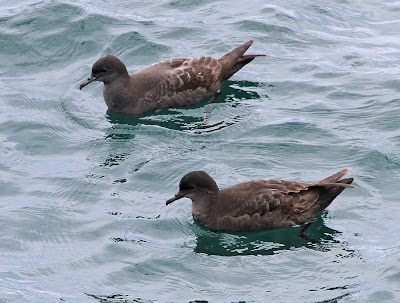
However, things did not look at all promising when we set out. There was a bit of weather about!

The rain and strong winds did not let up for about the first 4 hours of the trip.

Just as the rain was easing, we let out our first net of the day, and voila, Short-tailed Shearwaters started arriving!

And arriving...

...and arriving! Eventually there were 13 birds in this little flock!
They came closer and closer as the net was pulled in till they were practically under the boat, as this clip shows.


The crew were happy to watch. At least now we didn't have to worry about any of the birds becoming dinner!



After Jeff's email about the possibility of Sooty Shearwater, all were scrutinized closely. Following some helpful correspondence with Jeff and other experts, we were much more clued up about what to look for.

Short-tailed typically has a high, rounded headshape, looks short-billed and has a rather 'cuddly' appearance.


Occasionally we found birds which consistently showed a flatter-crowned headshape and consequently appeared longer-billed. However, compared to Sooty (see this link), these birds are shorter-billed and have noticeably larger eyes (which contributes to their more appealing expression). Sooty looks 'piggy-eyed' by comparison.


In flight, Short-tailed has rather concolourous pale underwings. Sooty typically shows more contrast on the underwing, with dark primaries contrasting with paler wing linings (see this link)


Sooty has narrower, more pointed and less 'paddle-shaped wingtips, and a subtly longer, more wedge-shaped tail (though the feet do often project beyond the tail tip). Also, Sooty is less likely to show a pale chin. Thanks to Jeff Davies, Rohan Clarke and Mike Carter for these tips!

The state of the feathers of these birds puzzled me. Most seemed to have very fresh body plumage, while the wing and tail feathers were more worn, sometimes much more so. According to Onley and Scofield's "Albatrosses, Shearwaters and Petrels of the World", "Timing of moult can be useful in separating Short-tailed from Sooty Shearwater. Adult Sooty Shearwaters moult body plumage from January-March during chick-rearing whilst Short-tailed Shearwaters wait until they reach the Northern Hemisphere in May. Thus birds with moulting, mottled body plumage during January-March are probably Sooty Shearwaters, while those moulting body plumage in May-July are more likely to be Short-tailed Shearwaters." These birds appear to have recently completed a body moult, which I am at a loss to explain, unless these are subadults which may moult earlier than adults.

This bird, with its uniformly fresh flight feathers, must be a juvenile.

Two more birds with an obvious contrast in wear between body and flight feathers.

Some individuals had markedly greyer throats and 'bridles' consisting of a pale eye-ring and line behind the eye (front bird).

This bird had already started its tail moult; the central pair were fresh.

The two birds with wings outstretched must be juveniles (uniformly fresh flight feathers).

Getting airborne with a belly-load of fish was quite an effort!


A couple more taken into the sun.
I've just discovered this superb pic of a Sooty Shearwater, posted yesterday! It shows just about all the key differences from Short-tailed - the head, bill and eye, and underwing pattern.
3 comments:
Excellent writeup and images Dave.
Oh mine...... those shearwater are like tame domestic ducks.... dono when would I be free to take such a trip.
Shear bliss.
Post a Comment